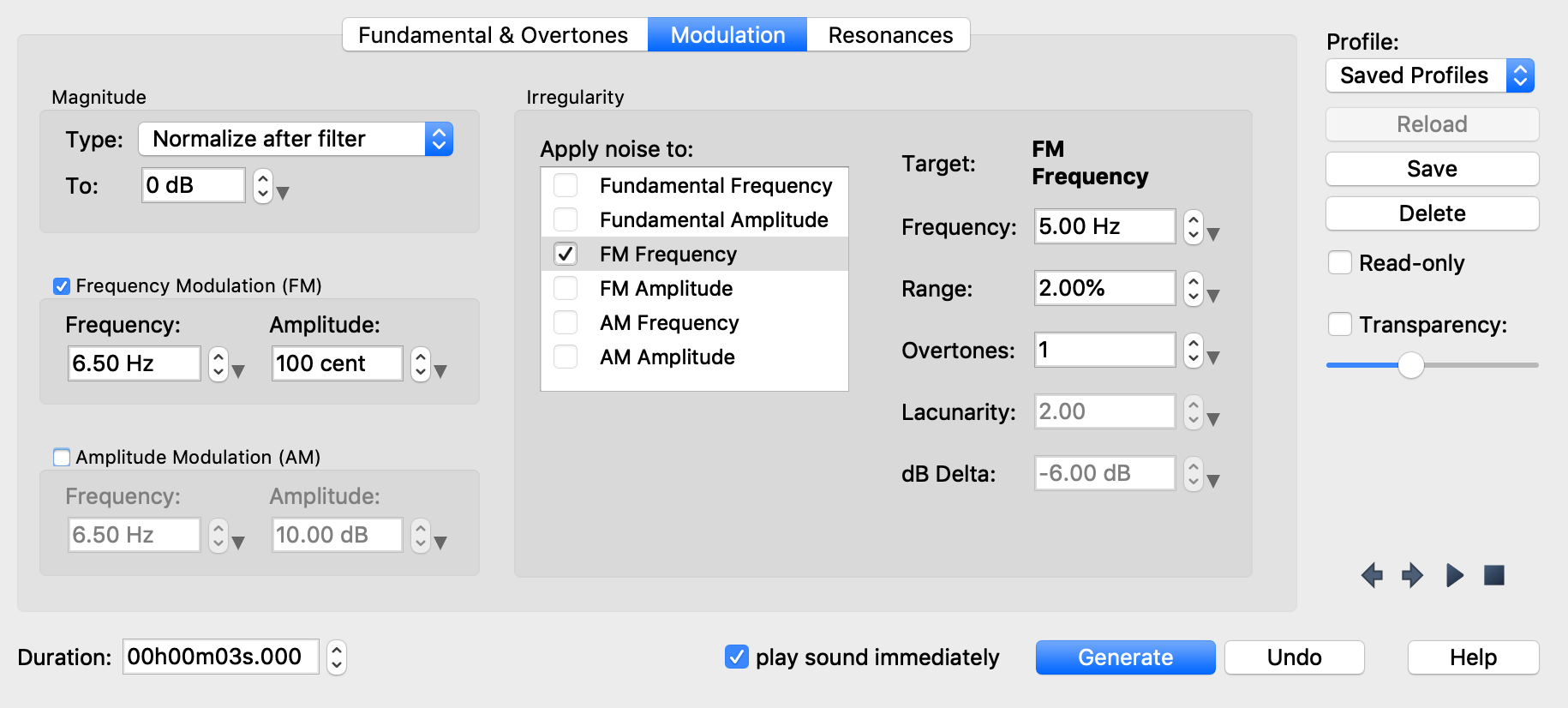Modulation
The modulation page offers several ways in which the generated sound can be changed. In particular, it has ways to affect (modulate) the intensity of the sound, and its frequency.
The words intensity, magnitude, amplitude, and loudness, all refer to the same thing, which is how loud the generated sound is. Each term has a slightly different meaning. When referring to individual points in time of a waveform, amplitude is the maximum deviation of the waveform away from its center, so it can be positive or negative. Magnitude is the absolute value of the amplitude. When referring to a longer waveform rather than individual points in time, amplitude and magnitude are often used synonymously, and in that case they both mean the absolute value of the maximum deviation from the center.
Intensity is a synonym for magnitude.
Amplitude, Magnitude, and Intensity can be measured in linear values, or in decibel. A value of 0 dB is the maximum intensity that can be represented in a digital waveform. It corresponds to a linear amplitude of 1.0. A value of -6 dB corresponds to a linear amplitude of 0.5, a value of -12 dB corresponds to a linear amplitude of 0.25, a value of -18 dB corresponds to a linear amplitude of 0.125, etc.
Loudness is a subjective measure that refers to the how loud a sound is perceived as by the listener. This depends on many factors such as the used speakers, their volume settings, and the ears of the listener. Therefore the software cannot say much about the perceived loudness of the sound, but it can indicate the relative intensity of the sound in qualitative terms, and it can indicate the mathematical magnitude of the sound.
The frequency affects the pitch of the generated sound.
This setting determines the overall intensity of the generated sound.
- Normalize after filter
The final intensity of the sound will be normalized to the entered value after the resonances have been applied.
- Normalize before filter
The generated sound will be normalized before it is filtered through the resonances. This can be used to compare the relative strength of different resonance settings. If the initial sound is too loud, this will generate clipping, so start with very low values, such as -40 dB.
This setting enables a periodic change of the fundamental frequency (or pitch), for example to create a vibrato effect in singing.
- FM Frequency
The frequency of the pitch modulation. In singing, typical values of a singer’s vibrato are around 6 Hz. That is the frequency with which the pitch of the fundamental will get faster and slower.
- FM Amplitude
This is the amount in cent by which the fundamental varies. A value of 100 cent will mean that the fundamental pitch will go up and down by one semitone.
This setting enables a periodic change of the intensity of the generated sound.
- AM Frequency
The frequency of the intensity modulation.
- AM Amplitude
This is the amount in dB by which the magnitude of the generated sound varies. A value of 6 dB means that the intensity of the sound doubles with each oscillation.
This section allows to make each of the preceding aspects of the sound generation less regular by adding noise to it. This can prevent sounds that appear too “computerized” and unnatural by being too perfectly regular. The added noise is of the type “Coherent Noise” that can also be used as a fundamental waveform. It is not a truly random noise, but has a frequency and an amplitude.
To add noise to a parameter, select it in the Apply noise to field, and then define the properties of the noise generator on the right side. There is some overlap between the different ways of adding irregularity to a sound, because ultimately all parameters will either change its frequency or its amplitude. This can be done directly by adding noise to the fundamental, or indirectly, by adding irregularity to the FM or AM modulation.
Also, this section will add coherent noise to the generator, which is somewhat random, but still periodic. To add pure white noise, use the setting on the Fundamental and Overtones page.
- Frequency
The fundamental frequency of the noise generator. For human singers, a value of 5 Hz is a good starting point for many irregularities in the voice. You can also set values that change extremely slowly by entering frequencies such as 0.1 Hz, or even 0.01 Hz.
- Range
The range, in percent, by which the affected parameter will increase and decrease. If the target is a frequency modulation, this will affect the pitch, in cent. If the target is an amplitude modulation, the percentage value will affect the intensity.
- Overtones
The number of overtones for this noise generator. If it is set to 1, only there will be only one level of noise at the given frequency. With more than one overtone, higher frequencies of noise will be added.
- Lacunarity
This determines the spacing between overtones. More precisely, it is the frequency ratio of successive overtones. This setting is equivalent to the
Multiply bysetting for overtone spacing. A setting of 2.0 means that all overtones are octaves of the fundamental.- dB Delta
The intensity reduction, in dB, for each successive overtone. This is equivalent to the
dB / Overtonesetting for the overtone amplitude.

